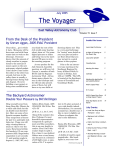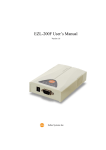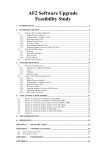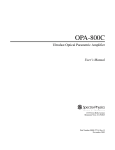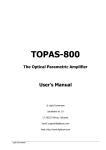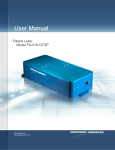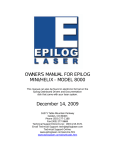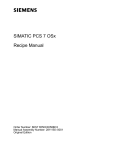Download BBSFG DFG 2011 Manual
Transcript
NDFG Non-collinear difference frequency generator Last Rev. 2011.09.21 NDFG User’s Manual PREFACE This manual contains user information for the non-collinear deference frequency generator (NDFG). Please, read this part of manual first before attempting to connect and/or operate NDFG. Non-collinear Difference Frequency Generator (NDFG) is used for TOPAS tuning range extension in infrared. This model provides the coverage of 2.6 – 20 m tuning range when pumped by parametric radiation from the output of TOPAS. The design of Non-collinear Difference Frequency Generator ensures the fixed direction of difference frequency radiation in all the tuning range. Model No. Interaction Wavelength range, nm _ _ 8 [U or F] 2WS SHI, SHS, SFI 533 – 2600 _ _ 8 [U or F] 3WS SHI, SHS, SFI, SFS 475 – 2600 _ _ 8 [U or F] 5WS SHI, SHS, SFI, SFS, FHI, FHS 290 – 2600 _ _ 8 [U or F] 6WS SHI, SHS, SFI, SFS, FHI, FHS, SHSFI, SHSFS 240 – 2600 Models with collinear difference frequency generator Model No. + C1 DFG1 2600 – 9000 (11000) Model No. + C2 DFG2 4000 – 15000 (20000) Model No. + C3 DFG1, DFG2 2600 – 15000 (20000) Models with non-collinear difference frequency generator Model No. + N1 DFG1 2600 – 9000 (11000) Model No. + N2 DFG2 4000 – 15000 (20000) Model No. + N3 DFG1, DFG2 2600 – 15000 (20000) In model number first letters _ _ represents the product type: TC – TOPAS-C, TT – TOPAS-Twins, T – TOPAS-800ps, TP – TOPAS-Prime. F – femtosecond pulses 60-200fs, U – Ultrashort femtosecond pulses 20-60fs. Light Conversion 2 NDFG User’s Manual DIMENSIONS Figure 1. NDFG housing Dimensions and positions of input and output ports. Light Conversion 3 NDFG User’s Manual TABLE OF CONTENTS PREFACE ................................................................................................................ 2 DIMENSIONS ........................................................................................................ 3 TABLE OF CONTENTS ............................................................................................ 4 LIST OF FIGURES .................................................................................................. 5 1. SAFETY PRECAUTIONS ................................................................................... 6 2. POSITIONING AND CONNECTION OF NDFG .................................................. 8 2.1. 2.2. 3. POSITIONING SCHEMES .......................................................................................................... 8 CONNECTION OF NDFG TO TOPAS .......................................................................................... 9 DESCRIPTION OF OPERATION OF NDFG ..................................................... 11 3.1. PRINCIPLE OF OPERATION .................................................................................................... 11 FIGURE 11. EXAMPLE OF HOW ANGLE BETWEEN SIGNAL AND IDLER DEPENDS ON DF WAVELENGTH.. 12 OPTICAL LAYOUT OF NDFG ............................................................................................................... 13 4. PREPARING NDFG FOR USE ......................................................................... 15 4.1. 4.2. 5. LOADING THE NDFG TUNING CURVE ..................................................................................... 15 SETTING UP THE NDFG CONFIGURATION .............................................................................. 15 TROUBLESHOOTING ..................................................................................... 16 SYMPTOM: THE DIFFERENCE FREQUENCY ENERGY IS TOO LOW. ....................................................... 16 SYMPTOM: THE BEAMS (AT THE OUTPUT OF NDFG) ARE NOT IN VERTICAL LINE................................ 16 SYMPTOM: WAVELENGTH OF DIFFERENCE FREQUENCY IS SHIFTED ................................................... 16 RECOMMENDATION FOR DETECTION OF DF BEAM ............................................................................. 16 AFFIX 1 ................................................................................................................ 17 List of nonlinear crystals for NDFG ........................................................................ 17 Light Conversion 4 NDFG User’s Manual LIST OF FIGURES Figure 1. NDFG housing Dimensions and positions of input and output ports. .............................. 3 Figure 2. Location of the labels on NDFG. Label description is given in Table 1. ........................... 7 Figure 3. NDFG shifted sideward from output of TOPAS; top view. ............................................. 8 Figure 4. NDFG shifted sideward from output of TOPAS and external Mixer1 is connected to TOPAS; top view. ............................................................................................................ 8 Figure 5. NDFG shifted sideward from output of TOPAS and external Mixers is connected to TOPAS; top view. ............................................................................................................ 9 Figure 6. Connectors of NDFG (in red rectangular): (a) NDFG front panel with IDC connector, ...... 9 Figure 7. Principle interconnection scheme for TOPAS system. ................................................. 10 Figure 8. Difference frequency crystal. ................................................................................... 11 Figure 9. Tuning curves for non-collinear difference frequency generation in AgGaS2 for three values of intersection angle of pump beams: a) ratio of difference frequency and signal wavelength, b) idler incidence angle versus DF wavelength, c) signal and idler intersection angle versus DF wavelength. Crystal cut angle deg. ............................................... 11 Figure 10. Tuning curves for non-collinear difference frequency generation in GaSe for three values of intersection angle of pump beams: a) ratio of difference frequency and signal wavelength, b) idler incidence angle versus DF wavelength, c) signal and idler intersection angle versus DF wavelength. Crystal cut angle deg. ......................................................................... 12 Figure 11. Example of how angle between Signal and Idler depends on DF wavelength. ............ 12 Figure 12. Beam routing of parametric signal. ......................................................................... 13 Figure 13. Beam path in NDFG. ............................................................................................. 14 Figure 14. The Position of the beams in space at the output of NDFG. Invisible DF beam in the top is at the fixed height. Signal height changes depending on the output wavelength. ............ 14 Figure 15. Load/Unload tuning curves menu ........................................................................... 15 Light Conversion 5 NDFG User’s Manual Safety precautions 1. SAFETY PRECAUTIONS The TOPAS system (optical parametric amplifier with non-collinear difference frequency generator) emits coherent electromagnetic radiation in visible and invisible to human eye (infrared and ultraviolet) spectral regions. The device cannot generate output energy without being pumped by a laser. However, the TOPAS system, when coupled with an appropriate pump laser, comprises a Class 4 laser system. The system users are responsible for taking appropriate safety training and ensuring compliance with local codes and regulations, which apply to Class 4 laser systems. It is imperative that users learn all safety information, which is provided in the pump laser’s manuals. All further information provided in this section should be considered as supplementary to the information provided there. The greatest concern when using TOPAS system is eye safety. Direct, reflected or scattered radiation present in/emitted from TOPAS system can cause permanent eye damage and possible blindness. Apart from that, the radiation present in/emitted from TOPAS system can cause skin or clothing burn, or ignite fire after hitting flammable substances even at some distance. The beams present in/emitted from TOPAS system are powerful enough to damage sensitive optical equipment such as video cameras and photodiodes. Because of these reasons the user is advised to follow safety measures listed below: 1. The TOPAS system together with its pump laser and supplementary equipment must be located in a locked area with access to authorized personnel only. This area must be marked by well defined warning signs, and be off limits to people not allowed to be there. 2. TOPAS system together with its pump laser must only be operated by qualified personnel who have received appropriate safety training and system’s user training. 3. Use protective eyewear at all times when aligning and operating the TOPAS system. Make sure that your protective glasses are rated to protect against all the multiple wavelengths emitted at TOPAS system output! Remember that the TOPAS system output wavelength can be automatically and continuously tuned in broad wavelength range, from ultraviolet to infrared (exact wavelength range of your system depends on the model). A few pairs of safety glasses may be needed to cover all the output range. Remember that parametric radiation and its harmonics can be beyond the range of human vision. Remember that the protective glasses, while protecting your eyes, also prevent from seeing the beams. Therefore be cautious even when using safety glasses. 4. Do not work with TOPAS system cover opened unless absolutely necessary. Intense light beams, their specular and scattered reflections can be emitted from various parts of TOPAS system when the cover is opened! 5. Maintain TOPAS system and all connected experimental setups considerably bellow eye level to prevent accidental beam encounter. Keep the beams enclosed where possible. Always be aware and inform other users of all the open air beam paths. 6. Avoid wearing watches or other objects that may reflect the beams. 7. Never look directly into any beam exit apertures or scattered beams from reflective surfaces including such surfaces as business cards. 8. Always keep the TOPAS system powered for the safety beam shutter to operate correctly. 9. Observe all other safety precautions given in the user’s manual. Maximum accessible radiation level from the TOPAS system: The TOPAS system, depending on the model, produces visible and invisible radiation continuously tunable in the maximum wavelength range of 185 to 22000 nm with a maximum of 50W of average pump power, and 5 mJ maximum energy per 20 to 300 femtosecond pulse. 10. Be very careful when aligning and working with the TOPAS system! Light Conversion 6 NDFG User’s Manual Safety precautions Description of all NDFG labels is presented in the table and picture below. Table 1. Description of NDFG labels No Label Description 1. Aperture label is located next to the output aperture of the “NDFG” and points to it. 2. Label for defeatably interlocked housing is located on the removable part of the protective housing. Figure 2. Location of the labels on NDFG. Label description is given in Table 1. Light Conversion 7 NDFG User’s Manual 2. 2.1. Positioning and connection POSITIONING AND CONNECTION OF NDFG Positioning schemes The positioning TOPAS and NDFG on the optical depends on the configuration. All standard positioning schemes is presented below. In these positioning schemes NDFG is shifted sideward from output of TOPAS and beam routing units are used to route the parametric signal in to NDFG. Beam routing mirrors are with metallic coating. First case of positioning is when only NDFG (without external Mixers) is connected to TOPAS is presented in Figure 3. Figure 3. NDFG shifted sideward from output of TOPAS; top view. In the second case external Mixer1 and NDFG is connected to TOPAS. Example of such scheme is presented in Figure 4. Figure 4. NDFG shifted sideward from output of TOPAS and external Mixer1 is connected to TOPAS; top view. Light Conversion 8 NDFG User’s Manual Positioning and connection To connect more external Mixers one can use such positioning scheme, see Figure 5. Figure 5. NDFG shifted sideward from output of TOPAS and external Mixers is connected to TOPAS; top view. 2.2. Connection of NDFG to TOPAS TOPAS and NDFG are connected together using the cable with IDC connectors. The IDC connectors are on the back panel of TOPAS and on the front panel of NDFG, see Figure 6 (a) and (b). Connectors for external mixers are on the back panel of NDFG, see Figure 6 (c). (a) (b) (c) Figure 6. Connectors of NDFG (in red rectangular): (a) NDFG front panel with IDC connector, (b) NDFG back panel with AMP connectors for external mixers (c) TOPAS back panel with IDC connector. Light Conversion 9 NDFG User’s Manual Positioning and connection The principle interconnection scheme for TOPAS system: TOPAS, NDFG and external Mixers are presented in Figure 7. Figure 7. Principle interconnection scheme for TOPAS system. Warning! Do not attempt to connect or disconnect IDC cable or external mixers, when the TOPAS is powered on. Before connecting and disconnecting any cable turn off TOPAS controlled board and disconnect the power supply cable. Light Conversion 10 NDFG User’s Manual 3.1. Description of operation of NDFG 3. DESCRIPTION OF OPERATION OF NDFG Principle of operation Nonlinear crystal #8 (AgGaS2 of I type phase matching) or #9 (GaSe of I type phase matching are used for non-collinear difference frequency generation (NDFG) when mixing signal and idler waves from the output of TOPAS. The diagram of non-collinear interaction is presented in Figure 8. Figure 8. Difference frequency crystal. Tuning of difference frequency pulse wavelength is accomplished rotating nonlinear crystal in vertical plane and changing the angle I-S between incoming beams. The angle I-DF between DF and Idler beam is kept fixed in all tuning range. The conversion efficiency is optimized adjusting time delay between interacting pulses (rotating time delay crystal). In Figure 9 and Figure 10 the examples of tuning curves for difference frequency generator with AgGaS2 and GaSe respectively are presented. (a) (b) (c) Figure 9. Tuning curves for non-collinear difference frequency generation in AgGaS 2 for three values of intersection angle of pump beams: a) ratio of difference frequency and signal wavelength, b) idler incidence angle versus DF wavelength, c) signal and idler intersection angle versus DF wavelength. Crystal cut angle deg. Light Conversion 11 NDFG User’s Manual Description of operation of NDFG (a) (b) (c) Figure 10. Tuning curves for non-collinear difference frequency generation in GaSe for three values of intersection angle of pump beams: a) ratio of difference frequency and signal wavelength, b) idler incidence angle versus DF wavelength, c) signal and idler intersection angle versus DF wavelength. Crystal cut angle deg. To keep the same direction of the difference frequency beam (when wavelength of DF is changing) the angle between Signal and Idler beams also changes, see Figure 11. Figure 11. Example of how angle between Signal and Idler depends on DF wavelength. Light Conversion 12 NDFG User’s Manual Description of operation of NDFG Optical layout of NDFG To route the beam (Signal and Idler) from TOPAS in to NDFG to metallic mirrors are used BR(Au) and BR-F(Au), see Figure 12. The mirror BR-F(Au) is so called Flipper (detachable mirror), one can detach it if NDFG is not used. Figure 12. Beam routing of parametric signal. Warning! Do not open dichroic mirror DM3(M12) (on TOPAS back panel) when signal is used for NDFG. The fresh pump can damage the metallic mirrors BR(Au) and BR-F(Au) and nonlinear crystals of DFG. Parametric beam (Signal and Idler) path is presented in Figure 13. The Signal and Idler is separated in dichroic mirror DM1. Signal beam is reflected to metallic mirror SM1, then to SM2 and to the dichroic mirror DM2. Idler beam is transmitted through DM1 and it is forwarded to the mirrors IM1 and IM2. From the mirror IM2 the beam is reflected to the mirror DM2. Then the idler beam is transmitted through DM2 into the NDFG Crystal stage and this stage in WinTOPAS program menu is named “NDFG Crystal”. Light Conversion 13 NDFG User’s Manual Description of operation of NDFG Figure 13. Beam path in NDFG. The mirror IM2 is placed on the translation stage to overlap signal and idler pulses in time. The mirror IM2 is named as “NDFG Delay “ in WinTopas program menu. The dichroic mirror DM2 is fixed on the motorized stage which rotates it in a vertical plane to change the vertical reflection angle of the signal beam. The DM2 is named as “NDFG Mirror “in WinTopas program menu. By changing the vertical angle of the mirror DM2 it is possible to keep the DF beam at the same height at the output of NDFG (Figure 14). Figure 14. The Position of the beams in space at the output of NDFG. Invisible DF beam in the top is at the fixed height. Signal height changes depending on the output wavelength. The DF beam is generated in the NDFG Crystal stage. From the NDFG Crystal DF, residual signal and idler beams are forwarded to the output port. All three beams travel at the different height (Figure 14). The Residual signal and idler beams should be blocked by the user outside the NDFG. For detection of DF beam it is recommended to use mid-infrared radiation sensitive material (liquid crystal sheet). The polarization of DF beam is horizontal. Light Conversion 14 NDFG User’s Manual 4.1. Preparing NDFG for use 4. PREPARING NDFG FOR USE Loading the NDFG tuning curve TOPAS system motorized stages are controlled through WinTOPAS program. All motorized stages are included in appropriate tuning curves, for example the OPA tuning curve consists of such motors: Crystal 1, Delay 1, Crystal 2 and Delay 2. The OPA tuning curve is named “OPA_06001.crv”. The interactions SHS, SFS, SFS, SFI are generated in Mixer1 and tuning curve for Mixer1 is named “Mixer1_06001.crv”. The tuning curve of Mixer2 (interactions: FHS, FHI, SHSFS and SHSFI) is named “Mixer2_06001.crv”. For more information about tuning curves and WinTOPAS program read WinTOPAS user manual. NDFG motorized stages (NDFG Crystal, NDFG Mirror and NDFG Delay) are included in NDFG tuning curve. The tuning curve for NDFG is named “NDFG_06001.crv”. Sometimes tuning curves for Mixer1 and NDFG are in different files so the user has to unload the tuning curve of Mixer1 (“Mixer1_06001.crv”) and to load the proper tuning for NDFG (“NDFG_06001.crv”) see Figure 15. Figure 15. Load/Unload tuning curves menu 4.2. Setting up the NDFG configuration The following steps have to be taken for setting up the NDFG configuration: 1. Close the shutter of TOPAS. 2. Check if DM3(M12) mirror is closed (TOPAS back panel). 3. Put BR-F(Au) mirror on magnetic pad to reflect the Signal and Idler to NDFG, see Figure 12. 4. Check the positions of DM1 and IM1 mirror places; they have to be in beam path (see Figure 13). 5. Check if the beam is centered on iris apertures A0 and A1. 6. Open the shutter of TOPAS. Light Conversion 15 NDFG User’s Manual Troubleshooting 5. TROUBLESHOOTING If troubleshooting and corrective procedures in this chapter do not solve the problem, contact your Light Conversion representative before taking further action. Symptom: The difference frequency energy is too low. Possible Cause: Corrective Action: Difference frequency wavelength can be in absorption range of gases in air. Purge the environment with nitrogen gas. The output energy (Signal + Idler) from TOPAS is too low Try to reset all motors of TOPAS. Check if beams are centered on iris apertures inside the TOPAS. For more information refer to TOPAS manual. The Signal and Idler beams are not collinear Adjust the input beam direction using the beam routing mirrors before TOPAS. Inspect the collinearity in longest distance as it is possible to do (recommended distance is 5-10 meters away from TOPAS). Beams are not centered on the iris apertures inside the NDFG Adjust the beam direction with routing mirrors (BR-F(Au) and BR(Au)). The positions of NDFG motors are misaligned Try to reset all motors of NDFG. Optical path between Signal and Idler (inside NDFG) is different Optimize the delay with motor “NDFG Delay” in WinTOPAS software. Symptom: The beams (at the output of NDFG) are not in vertical line Possible Cause: Corrective Action: The Signal and Idler beams are not collinear Adjust the input beam direction using the beam routing mirrors before TOPAS. Inspect the collinearity in longest distance as it possible to (recommended distance is 5-10 meters away from TOPAS). Slightly adjust the DM2 mirror in horizontal plane. Symptom: Wavelength of difference frequency is shifted Possible Cause: Corrective Action: The wavelength of Signal and Idler can be shifted Try entering different wavelength of NDFG Recommendation for detection of DF beam For detection of invisible beams one can use liquid crystal sheets, for more information refer to Chapter 2.2 on page 12. Light Conversion 16 NDFG User’s Manual Affix 1 AFFIX 1 List of nonlinear crystals for NDFG Crystal numbe r #8 #9 Crystal Nonlinear Process Crystal placement DFG1 Output wavelengths and polarization 2600 – 11000 V NDFG Crystal rotation axis H AgGaS2 = 39 GaSe = 0 DFG2 5000 – 20000 V NDFG H S – signal pulse generation I – idler pulse generation DFG – difference frequency generation when mixing signal and idler pulses. Light Conversion 17

















